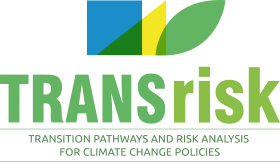Risks are associated with policies to combat climate change and can be divided into two broad categories: Implementation risks and Consequential risks. TRANSrisk research has shown that the number and nature of risks that can be assessed using economic models is limited. Assessment work generated outcomes at the level of case studies and at meta-level. Shows how assessment of risks and their underlying dimensions changes depending on an expert’s professional background with different stakeholder groups.
Any mention of risk in relation to climate change will conjure thoughts of extreme weather events, rising sea level and the potential cost of inaction. However, risks are also associated with policies to combat climate change. Our understanding of the interplay between risks and the policies they affect is poor. To expand knowledge in this area the TRANSrisk project is exploring how risks may enhance or constrain different carbon mitigation pathways.
Categorising and assessing risk
The principal way to reduce climate-related risks is to cut greenhouse gas emissions. However, carbon reduction policies are themselves associated with a host of additional risks, which need to be assessed and evaluated in the policy making process. These risks can be divided into two broad categories: those affecting the design and implementation of policies (implementation risks), and those that may result from implementing these policies (consequential risks).
Most approaches to risk assessment are numerical, based on actuarial methods and statistical models. However, these approaches reach their limits when the issues grow in complexity and the risks affect several stakeholders (or groups of stakeholders). Our research has shown that the number and nature of risks that can be assessed using economic models is extremely limited, especially when compared to the range of risks perceived by different stakeholder groups (see D5.2 ‘Quantitative Appraisal of Climate Policy Risks’, available by request).
Working with experts
In our latest work, we developed a standardised survey and workshop ‘blueprint’ to assess risks via expert stakeholders. Both the survey and workshop design are being applied across most TRANSrisk country case studies, but at the time of writing results are only available for the UK (nuclear energy), Switzerland (phase out of nuclear energy) and Greece (1. photovoltaic electricity, and 2. energy efficiency in buildings). For each case study, our main interest lay in assessing risks with different expert groups.
Assessment of risks, even when carried out by experts, is never truly objective. However, experts have a more comprehensive and refined knowledge base than a layperson, which allows an assessment beyond an exclusively intuitive perception. Even then evaluations of risk, and what people consider to be a risk at all, can vary enormously depending on the stakeholder group an expert represents. For example, one group’s loss may be another group’s gain.
Expert assessment of risks helps us identify important risks and understand them better. This in turn can help make policies more robust and sustainable. Comparing assessments from experts representing different stakeholder groups can also help identify potential conflicts before they occur, allowing mitigation measures to be planned in advance.
Dimensions of risk

We can assess risks along various dimensions. The two most commonly discussed dimensions are likelihood of occurrence and severity of impact. These two dimensions are often used in project risk assessment to prioritise risk mitigation efforts.
Other, less commonly used dimensions are concern (or worry) and when a risk may occur. Concern is a more tangible, less technical way of assessing the perceived importance of a risk than using likelihood/ severity. When a risk will occur is likely to affect mitigation action – a risk that may occur years in the future is likely to receive less attention than one that could happen very soon.
Our, or society’s, ability to actually reduce a risk is another dimension, which we can use to better understand certain risks. If experts feel that a risk can, or cannot, be easily be managed it may be a decisive factor in any decision making process.
Results overview
Our assessment work generated outcomes at two levels. The first was at the level of case studies, where we asked how experts assess risks along alternative risk dimensions, and examined whether assessments were consistent across the various expert groups. The second was at a meta-level (higher level), where we explored the how experts assess the different categories and dimensions of risks, which helps improve our understanding of the role of expert risk assessment in policy making
The biggest challenge in this work was the need to achieve some level of standardisation across case studies, as they all have very different political, cultural, and socio-economic settings. This limits which results we can compare, and which results are confined to the individual case study setting.
At the meta-level, we found that experts are more concerned about implementation risks than consequential risks. This may because these risks are, by nature, relatively immediate and well defined.
Our results around risk dimensions were not fully conclusive, and we will need more data for decisive results with respect to the usefulness of each dimension. For now, we can say that experts prefer the better-known dimensions – likelihood and severity of impact – for assessing risks.
Level of concern seems to be a good proxy for the severity of impact, but not for the likelihood of it occurring. This might suggest that the respondents perceive the potential impact of a risk as the main cause of concern, potentially relegating other risk dimensions to technicalities that should (and could) be addressed relatively easily in the policy making process.
Case study specific results

As our case studies are all exploring different areas in different countries, the highest ranked risks were obviously very different. Nevertheless, in each case study there was general agreement on several key risks across most stakeholder groups. For example, in Switzerland community opposition was considered the most urgent barrier to building renewable energy infrastructure. By contrast, in the Greek studies complex bureaucratic processes, and a general distrust in government institutions, were perceived to be the most urgent risks
Agreement did not, however, hold true across all risks, and our research revealed some significant differences between stakeholder groups. For the UK ‘no new nuclear’ case study scenario we observed relative consistent views between stakeholders from academia and consultancies, but substantial differences when compared to the industry representatives. In the Switzerland case study, the results highlighted substantial differences in views between academics and consultants on one hand, and environmental protection groups on the other.
In the case of photovoltaic energy in Greece, we found electricity operators and policy makers to have different views on several risks. We saw a similar difference of options in the Greek energy efficiency in buildings case study, notably between technology users / suppliers and policy makers. However, in both Greek case studies, policy makers viewed risks in a similar way to scientists.
Applications and future work
These results show how assessment of risks and their underlying dimensions changes depending on an expert’s professional background/association with different stakeholder groups. This stresses the need for careful consultation design around climate policies, and for prudent interpretation of information on risks when this comes from a single group of stakeholders. Policy makers could, for example, actively seek wider views when encouragement or opposition to a technology is coming from a single stakeholder group.
Results from other case studies are expected soon, meaning that we will be able to validate these results. Using this larger data set, our work on risk and uncertainty will move onto a multiple-criteria decision analysis (MCDA), again using data from our case studies. MCDAs help us understand how multiple conflicting criteria affect decision-making.
The process will produce a more detailed assessment and weighing of some of the mitigation pathway risks explored in the TRANSrisk case studies. As with our previous work in this area, input from expert stakeholders will be used to identify and explore relevant risks. We expect to complete this work (D5.5 ‘Multi-criteria consideration of risk and uncertainty for climate policy’) in May 2018.
Notes
This article is based on the TRANSrisk Deliverable D5.4 ‘Public and expert opinions on the importance of climate policy risks’, which is available on request. For more information please see our website.
Photo credits
Photo 1 by Sean Davis, licenced under CC BY-NC-ND 2.0
Photo 2 by Sam Antonio Photography licenced under CC BY-NC-ND 2.0
Photo 3 by Asian Development Bank, licenced under CC BY-NC-ND 2.0
TRANSrisk
Project details
- Project title: “Transitions Pathways and Risk Analysis for Climate Change Mitigation and Adaption Strategies” (TRANSrisk)
- Funding scheme: European Union Horizon 2020 Programme (EU H2020, grant agreement no. 642260)
- Duration: 3 years (1 September 2015 – 31 August 2018)
- Project coordinator: Science Policy Research Unit, University of Sussex, United Kingdom
- Project website: www.transrisk-project.eu



